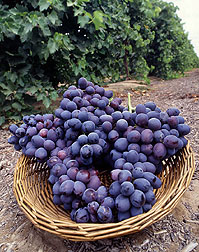This page has been archived and is being provided for reference purposes only. The page is no longer being updated, and therefore, links on the page may be invalid.
|
|
Examining the Many Faces of XylellaBy Marcia WoodDecember 18, 2003 Thousands of southern California grapevines were wiped out several years ago by a devastating affliction known as Pierce's disease. The disease is the work of a microbe called Xylella fastidiosa (pronounced ZYE-lell-uh FAS-tid-ee-oh-suh). Harmless to humans, X. fastidiosa is carried from one grapevine to the next by insects such as the glassy-winged sharpshooter. But it's not just grapevines that are beleaguered by X. fastidiosa and sharpshooters. The microbe occurs in many forms, or strains, that sicken other plants, including almond, citrus, peach, plum and oleander. Agricultural Research Service experts at the agency's San Joaquin Valley Agricultural Sciences Center at Parlier, Calif., are sorting out who's who in the world of Xylella. They're doing that by comparing the microbes' genetic material, or DNA. Molecular biologist Jianchi Chen is developing a DNA-based test that would determine which strain of Xylella--if any--certain plants are harboring or specific insect pests are carrying. Results of the DNA test could give growers of vulnerable plants a valuable heads-up. In addition, the assay would give agricultural inspectors a fast, accurate way to make sure that shipments of plants for commercial orchards or backyard gardens are free of Xylella. Currently, plants sometimes have to be monitored for weeks or even months to be certain they're disease-free. Chen and his colleagues in the ARS Exotic and Invasive Diseases and Pests Research Unit at Parlier--plant physiologists Hong Lin and Fred Ryan and entomologists Elaine Backus and Russell Groves--are each pursuing unique investigations of Xylella, the sharpshooters that spread it, and the diseases it causes. ARS is the U.S. Department of Agriculture's chief scientific research agency. |


